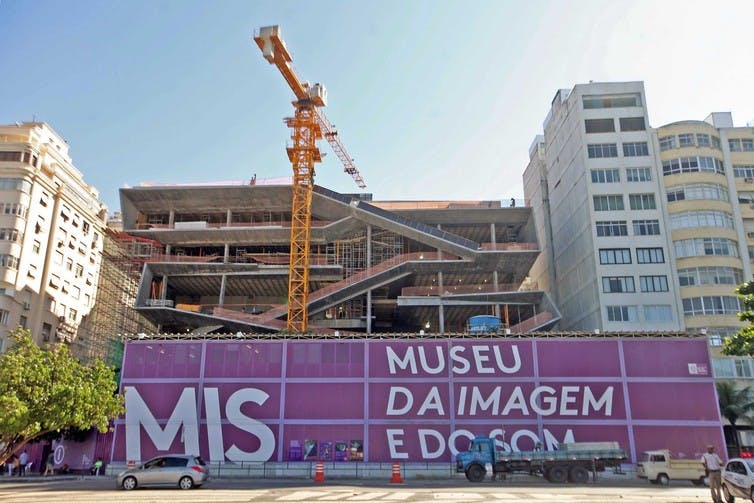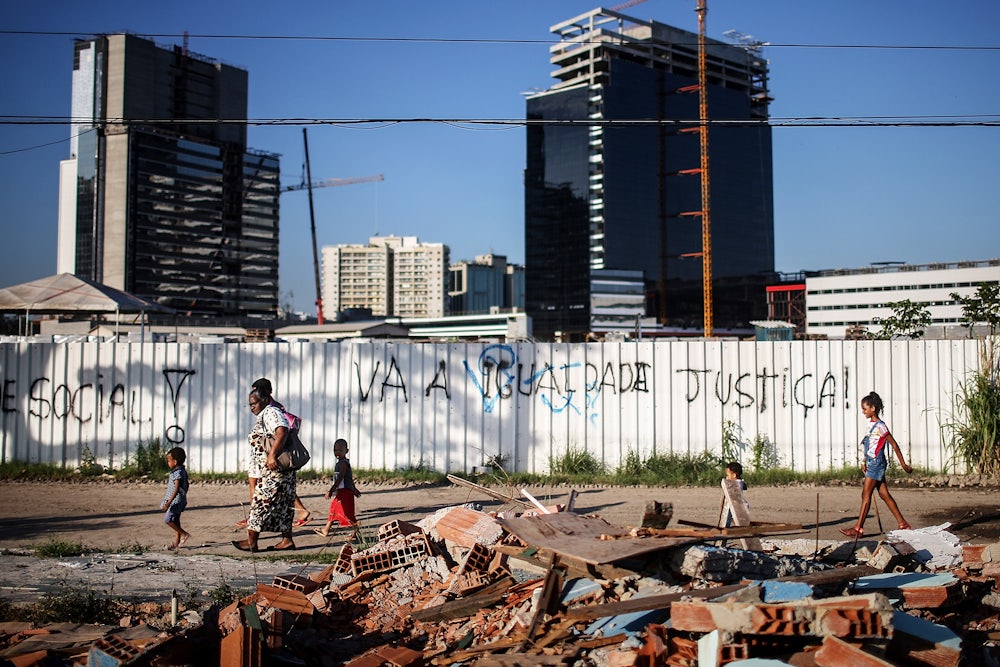It was raining on May 12, the last time I was in Rio. The cidade maravilhosa – the “Marvelous City” – was cold and dark, the furthest thing from the vibrant, jovial landscapes you’ll see on a Google image search.
The rain didn’t deter thousands of workers pulling 12-hour shifts to finish construction for the 2016 Summer Olympics, but the overall mood was just as gloomy; May 12 was also the day that the Brazilian senate voted to suspend President Dilma Rousseff and begin an impeachment trial.
I’ve been to Rio dozens of times, and because I’m a scholar of modern architecture and public space, I couldn’t help but look at how the city had changed, for better or worse, in preparation for the Summer Olympic Games.
As I rode an Uber for two hours from Rio to the airport, seeing construction everywhere, I knew how closely related it was to the country’s political problems. Kickbacks from large infrastructure projects were used to finance campaigns of all major political parties.
I started asking myself the question that I’m sure every citizen of Rio will entertain, in one way or another, in the near future. Was is worth it? What would be the legacy of all this construction – if not the demolition of Brazilian democracy happening right before our eyes?
The construction frenzy tied to the Olympics should lead to much-needed infrastructure improvements, and the Rio Olympics did spur the development of a number of museums and cultural institutions. But that development – often conducted behind closed doors, with little public accountability – has come at a cost.
Buildings that benefit whom?
Two blocks after leaving my hotel, my Uber passed one of these new museums: the MIS (Museu da Imagem e do Som, or “Museum of Image and Sound”).
An elegant and complex structure designed by American architects Diller, Scofidio and Renfro, the building – which broke ground in 2014 but won’t be ready in time for the Olympics – projects a series of ramps on the main facade. The visitors will have a hard time deciding if they should look to the collection inside or to the bright Copacabana beach outside. I commend the architects for offering the choice instead of blocking the view (as others proposed). Nevertheless, a recent PhD dissertation by scholar Lidia Quieto revealed how opaque the competition process – organized by the powerful Roberto Marinho Foundation, the cultural arm of the Brazilian media conglomerate Rede Globo – really was.

Does it have to be like that? Could an architectural competition be held with transparency and public spirit in mind?
Apparently, not in Rio.
This general disregard for the public good has bled over to decisions tied to Olympics. Years ago I interviewed Gabriel Solis, a San Antonio-based architect who served on the jury of the competition for the Rio Olympic Park. The proposed location sat on marsh lands that are extremely sensitive to land removal and vulnerable to erosion. But Solis told me that environmental concerns were simply cast aside during the decision-making process. At the time – in 2014 – Solis was happy that the jury had at least managed to guarantee the permanence of Vila Autódromo, an informal settlement that occupied a tiny part of the site.
Two years later, on the verge of the opening of the Olympic Games, Vila Autódromo is no more. Because the developers didn’t want a favela anywhere near the apartments they’d need to sell after the Games, the city negotiated with individual occupants and demolished their houses as soon as they agreed to leave. Living in the middle of rubble and under the threat of forced relocation, the majority of the families accepted the city’s cash offer and left. The 25 families that resisted until the end will still have their homes demolished, but will be able to inhabit new ones built in their place.
The pluses and minuses of the new port
My Uber continued to Downtown Rio, where people weren’t so lucky. The redevelopment of the port area – Porto Maravilha – removed 22,059 families from their homes.
But the port area also contains one of the few positive outcomes of Rio 2016: The demolition of the Perimetral, a double-decker highway that used to snake along the seashore. As we rode through the congested streets of downtown Rio on that rainy afternoon, the traffic wasn’t ideal. But it also wasn’t any worse than it was a few years ago with the elevated highway. Visiting Paço Municipal (the old imperial residence) and viewing Guanabara Bay – unobstructed by the Perimetral – is a sight to behold.
Half a mile north are two new museums: one that celebrates everything good about contemporary architecture and one that epitomizes everything wrong with it. The Museu de Arte do Rio (Rio’s Museum of Art) is the good one. Here two existing buildings were renovated by the firm Bernardes Jacobsen; they’re now connected by an elegant new canopy that creates a pleasant terrace. It doesn’t hurt that the Museu de Arte also has a wonderful collection of art, with a focus on works that have made Rio their subject matter.
Across the Museu de Arte, sitting on a white-stoned platform that is blinding on sunny days, is a strange metallic structure designed by world famous Santiago Calatrava. Called Museu do Amanhã (“Museum of Tomorrow”), it seems to be no more than a symbol of a lost opportunity. The museum has no collection, just a series of virtual displays; when I visited, the exhibits couldn’t hold my attention for more than a few seconds each. What I did notice was how foreign and unfit that big white skeleton looked in Rio. Did I mention that, much like the Olympics, Calatrava’s projects are notorious for going way over budget?
A model of city building gone awry
As the Games begin, it has become clear that Rio 2016 is already a missed opportunity. The subway extension to Barra da Tijuca will operate only on a limited schedule (probably for Olympic ticket holders only). The light rail downtown will also operate on a reduced course. Of the two big architectural monuments tied to the Games, one will not be ready (Museu da Imagem e do Som) and the other (Museu do Amanhã) isn’t worth a visit. Thousands of families were displaced; thousands of apartments will take their place and make gentrification worse than it already is.
Yes the Bus Rapid Transit lines are working fine, while both the TransOeste and the TransCarioca bus corridors are operating at full capacity, serving half a million people everyday and reducing carbon emissions by 40 percent. But one new piece of infrastructure has already collapsed: On April 21, a 50 foot-long piece of a dedicated bicycle lane that had opened in January collapsed into the ocean, killing three cyclists.
All this should be just another case of bad infrastructure planning and investment. But it’s much worse. Over the past 20 years, Rio has implemented an entire model of city building that’s relied on gentrification, campaign finance kickbacks and forced relocations; now that model is being used by the entire country. As The New York Times recently wrote, the political party that ruined Rio is the same that is supporting a coup against Dilma Rousseff.
It’s sad that the Rio 2016 Olympics might be remembered for three collapses: The demolition of the downtown Perimetral highway (1960-2016), the collapse of the bicycle lane (January to April 2016), and the implosion of Brazilian democracy (1985-2016).
Rebuilding the last will be an Olympic proposition.
![]()
This article was originally published on The Conversation. Read the original article.
